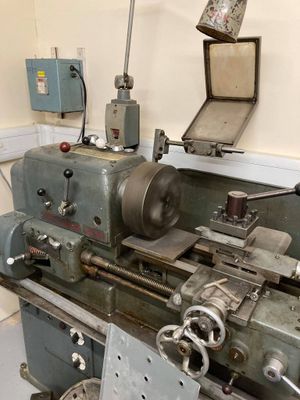Metal Lathe: Difference between revisions
More actions
NCMReynolds (talk | contribs) Created page with "=General Info= thumb|right|Harrison L5 Mk1 The Hackspace has a Harrison L5 Mk1 metalworking lathe. Metalworking lathes are dangerous machines and you..." |
|||
| Line 3: | Line 3: | ||
[[File:MetalLathe.jpg|thumb|right|Harrison L5 Mk1]] | [[File:MetalLathe.jpg|thumb|right|Harrison L5 Mk1]] | ||
The Hackspace has a Harrison L5 Mk1 metalworking lathe. Metalworking lathes are dangerous machines and you should not attempt to use it without an induction. Details on the induction process are TBC. | The Hackspace has a Harrison L5 Mk1 metalworking lathe. Metalworking lathes are dangerous machines and you should not attempt to use it without an induction. Details on the induction process are TBC. | ||
Level 1 training | |||
Level 1 training consists of a single course which is designed to take a complete beginner through all the essential skills needed to produce basic but functional parts on a lathe. It will also act as a good refresher/ competency test for those who already have experience from elsewhere. Members must start by watching the recommended videos listed below, to learn as much of the theory in advance – although no substitute for practical experience, machining is a skill where a firm grasp of both is essential and there will not be time to cover both in the induction session. We will start the training session by re-capping the theory and going over the key safety concerns before we move onto taking our first cuts with an external turning tool, facing and turning. We will then introduce the tailstock and explain its role in supporting long workpieces and use it to drill a hole. Finally, we will demonstrate how to measure the work and use the DRO to work to dimensions. The course will end with a semi-supervised test part which you will make, putting the skills you have learned into practice. Note that level 1 only considers use of a 3-jaw chuck, level 2 training is required for other work holding methods. This course usually requires a fee (which goes into a pot for future LHS purchases). This is usually £40, but can be reduced if this is too much for you to pay – please speak to your trainer in advance – we don’t want this to be a barrier to entry. | |||
Beginner users should watch the following training videos before booking a session: | |||
([https://www.youtube.com/watch?v=H6Dnmd3lDzA Lathe Theory]) | |||
([https://www.youtube.com/watch?v=FL0Rz_ip6Is Tool Bits]) | |||
([https://www.youtube.com/watch?v=r9AqbENiLOQ Facing]) | |||
([https://www.youtube.com/watch?v=AA5i8X1RQ8U Tail Support]) | |||
([https://www.youtube.com/watch?v=1IsG8vIXA8k Turning]) | |||
([https://www.youtube.com/watch?v=HotV4HtmR6Y Chatter]) | |||
([https://www.youtube.com/watch?v=aQwWRW-PdTE Turning to a Shoulder]) | |||
([https://www.youtube.com/watch?v=IHquZSsM_k0 Drilling]) | |||
([https://www.youtube.com/watch?v=1Fgj7m4MTbw Surface Finish]) | |||
([https://www.youtube.com/watch?v=yBVo8wufsCE Choosing Materials]) | |||
([https://www.youtube.com/watch?v=NrcDr2WO6Ho Feeds and Speeds]) | |||
([https://www.youtube.com/watch?v=-mNH1ZLy-hk Additional Video on Surface Finish]) | |||
Note - most of the videos above are from the Blondihacks 'lathe skills' video series. This whole series is filled with useful content and we would fully recommend watching the rest, although this is not compulsary for a level 1 training session. | |||
One of London hackspaces lathe trainers has provided notes here: File:[https://wiki.london.hackspace.org.uk/view/File:Toby%27s_Lathe_Training_Notes_r03.pdf Toby's Lathe Training Notes r03.pdf]. Other trainers will do something similar, but might not follow this exact plan | |||
Revision as of 12:33, 29 January 2023
General Info

The Hackspace has a Harrison L5 Mk1 metalworking lathe. Metalworking lathes are dangerous machines and you should not attempt to use it without an induction. Details on the induction process are TBC.
Level 1 training
Level 1 training consists of a single course which is designed to take a complete beginner through all the essential skills needed to produce basic but functional parts on a lathe. It will also act as a good refresher/ competency test for those who already have experience from elsewhere. Members must start by watching the recommended videos listed below, to learn as much of the theory in advance – although no substitute for practical experience, machining is a skill where a firm grasp of both is essential and there will not be time to cover both in the induction session. We will start the training session by re-capping the theory and going over the key safety concerns before we move onto taking our first cuts with an external turning tool, facing and turning. We will then introduce the tailstock and explain its role in supporting long workpieces and use it to drill a hole. Finally, we will demonstrate how to measure the work and use the DRO to work to dimensions. The course will end with a semi-supervised test part which you will make, putting the skills you have learned into practice. Note that level 1 only considers use of a 3-jaw chuck, level 2 training is required for other work holding methods. This course usually requires a fee (which goes into a pot for future LHS purchases). This is usually £40, but can be reduced if this is too much for you to pay – please speak to your trainer in advance – we don’t want this to be a barrier to entry.
Beginner users should watch the following training videos before booking a session:
(Facing)
(Turning)
(Chatter)
(Drilling)
(Additional Video on Surface Finish)
Note - most of the videos above are from the Blondihacks 'lathe skills' video series. This whole series is filled with useful content and we would fully recommend watching the rest, although this is not compulsary for a level 1 training session.
One of London hackspaces lathe trainers has provided notes here: File:Toby's Lathe Training Notes r03.pdf. Other trainers will do something similar, but might not follow this exact plan
